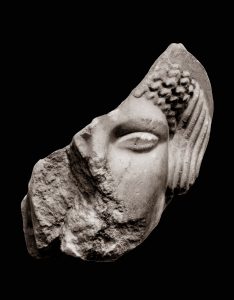Scratched graffito with blasphemous crucifix
This portion of white plaster with scratched graffiti was discovered in 1857 in the so-called Paedagogium, a building annexed to the imperial palace on the Palatine where the imperial family’s slaves likely received their training. The graffito represents a human-like figure affixed to a cross, seen from the rear, wearing a short, sleeveless tunic and possessing the head of a donkey. On the left, a man turns his face and raises his left arm towards the crucifix. In the lower register, a caption in ancient Greek states, “Alexamenos worships [his] god”, written across four lines with irregularly drawn letters. In the upper right corner is a Y, interpreted both as a cry of pain and as the symbol of a pitchfork. The graffito, difficult to interpret, has been dated to the Severan age (late 2nd – early 3rd cent. AD), and appears to be one of the earliest representations of a crucifixion. The scene is probably meant to mock a Christian, possibly the Alexamenos in question.




